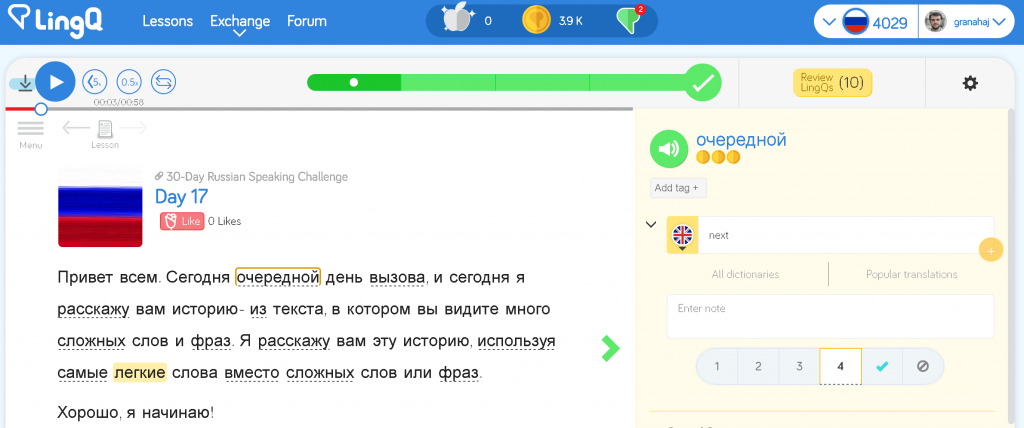A 5-Step Method to Improve Your Listening Skills
Let’s talk listening skills. Do you remember how you felt the first time you heard someone speak your target language?
Bamboozled?
Personally, I’ve always found listening to be the most difficult language learning skill. Maybe you feel the same way?
In this post, we’ll look at the key to improving your listening and I’ll share the method I use to work on my listening skills.
One the reasons I used to struggle with listening is that I didn’t really know how to practice it. Should you read along while you listen or should you listen without a text? What should you listen to? Do you need to translate every single word?
I had many failed experiments when I first started learning Spanish and it took me a long time to figure out the best methods to practice my listening skills.
In fact, it was only when I moved to Argentina that I finally realised what I needed to do to improve my listening and I discovered it somewhat by accident! Before I arrived in Buenos Aires, I thought my Spanish was pretty good. Then I landed and I couldn’t understand anything! It was a bit of a baptism of fire! On the bus, in the supermarket, no matter where I went I found myself smiling, nodding and desperately trying to work out what people were saying to me.

However, over the coming weeks and months my listening skills began to significantly improve and this taught me a very valuable lesson: To improve your listening skills, you have to truly listen. You have to listen with focus and attentiveness. Passively listening to things you don’t understand is never going to work.
I was forced to do this because I’d moved to a new country where most people don’t speak English very well and I had to figure out how to get by. But the same concept applies whether you’re travelling abroad or learning the language from home. Active listening, not passive listening, is what will give you results.
Passive vs. Active Listening: What’s the Difference?
Why Passive Listening Doesn’t Work
What is passive listening? Passive listening is when you listen to something without giving it your full attention. For example, you put on French radio in the background while you’re working, or listen to Spanish music without really paying attention to the lyrics.
Passive listening doesn’t work because basically … you’re not really listening! You’re doing something else – it could be working, sleeping or daydreaming – rather than actually listening to the sounds. When you listen this way, you can’t just expect to suddenly understand everything you’re hearing.
Think about it. Even in English, we don’t remember things or understand them unless we actually pay attention to them. For example, lots of people like to have the radio on in their kitchen while cooking or in the morning while having breakfast. Maybe you do this too. But how much of what you hear do you actually remember? If you’re being honest, very little because you weren’t really listening. You might remember a particular song you like or something important that was mentioned on the news but unless you actually try to focus on what you’re listening to, most of it goes in one ear and out the other.
Since that’s what happens with our native language, why do we think doing the same thing in another language will give us different results?
The idea of passive learning is appealing because it promises results without much work. But the truth is that it just doesn’t deliver on those promises. If you’re spending time passively listening as part of your core language learning, it’s time to stop and start practicing more efficiently instead.
Don’t get me wrong, there’s no harm surrounding yourself in the language by having music or radio playing in the background while you’re in the kitchen or while you’re reading a book. You’ll still pick some things every now and again when a particular word or phrase catches your attention. Just don’t let passive listening become the foundation of your how you work on your listening skills. To really see predictable, sustainable results you need to practice listening in a more focused way.
Why Listening Needs to be Active
Your brain needs you to bring attention to things to remember them.
By paying close attention to something and repeating it multiple times, you send a clear message to your brain that something is important and needs to be remembered. This obviously applies to things like learning vocabulary but it’s also true when it comes to the other parts of listening, including sounds, accents, intonation or phrasing. You need to bring attention to them. That’s why it’s important to listen actively rather than passively when you practice.
Another reason to practice active listening is to get used to differences between how words sound on their own and how they sound in context. Native speakers often ‘smash’ words together when they speak. We do this ourselves in English. For example, in American English the phrase ‘what’s up?’ often sounds more like ‘wassup?’ or in Hiberno-English a greeting like ‘how’s it going?’ often becomes ‘howsagoin?’
These are things we take for granted in our native languages but when you hear such transformations in a foreign language, they can leave you totally lost!
That’s why sometimes you might know a word but not recognise it when you hear it because the sounds mutate when they're spoken together rapidly by native speakers. This is one of the many reasons why focused listening practice is important. Just learning individual words isn’t enough. You need to hear how these words sound and appear in context and that’s not something you can pick up passively. Learning new words but never hearing them isn't sufficient when it comes to high level, real-life conversation.
So how can you go about practicing your listening skills in a more active way and what kind of materials should you practice with?
The Tools You Need to Improve Your Listening Skills
I suggest using a language resource that contains both audio and a text transcript. The main reason for this is so that you can check your comprehension when you listen to something new. It’s always good to listen without a text first to really test yourself, but it’s very useful to have a text or transcription so you can check your understanding afterwards.
Here are some ideas for materials you could use to practice with:
- A scene from a movie or tv show (+ the subtitles)
- A podcast episode you have a transcript for
- A video on Euronews or another news site
- A YouTube video with a transcription
- A book in print and audiobook format
- Dialogues and their transcription
- An Assimil course
- LingQ
- Textbook audio and text

When practicing your listening skills, I would always suggest working with a short audio clip of no more than three or four minutes. There are a couple of reasons for this. Firstly, unless you’re at an advanced level, long clips are exhausting! Secondly, as you’ll see, repetition is an important part of the learning process. Working with short clips means you can easily listen to them multiple times. Besides, there’s much more value in working with a short clip and learning it well than working with a longer one and not examining it in any real depth.
If you spend half an hour working with a single three minute clip, you’ll be able to listen to it multiple times, look up what you don’t understand and repeatedly hear the new words and phrases you come across. On the other hand, if you work for half an hour with a 15 or 20 minute audio clip, you won’t have time to repeat the audio, and you may only hear each new word once or twice. You can’t really do this and expect to remember very much of what you learned a few days later.
Finally, I strongly suggest that you think carefully about the content of the materials you choose and find things that cover topics that are important to you. Fluency doesn’t require you to know every word in the dictionary. It just requires you to know the words you’re going to need in the conversations you’re going to have. Think about the kind of things you’re actually going to want to or need to talk about in your target language and choose your materials accordingly. That way you can ensure that you’re learning vocabulary that directly improves your ability to use the language.
Now that’s the groundwork explained, here’s my five step method to improve your listening skills.
A 5-Step Method to Improve Your Listening Skills
Step 1: Listen to the Audio – No Reading!
The first step in this method is to simply listen to the audio alone. Don’t read the text in advance and don’t follow along with it as you listen. The point here is to focus solely on your aural skills and see how much you can understand without any visual aid.
Of course, unless you’re already at a very high level, this can be very difficult. Rather than trying to understand every single word, it’s better to focus on trying to understand the ‘gist’ of what’s being said.
See if you can pick out some key words or phrases that might give you an idea of what’s being said and note them down. Find anything at all that you can cling on to and you’ll be able to use this as starting point to learn more from the context.
Step 2: Repeat!
It’s not time to look at the text just yet. Many learners make the mistake of turning to the text too quickly. However, the point here is to practice your listening skills so just stay focused on listening for the time being.
On the first listen, you’ll probably have identified one or two key words or ideas. As you repeat the audio, listen carefully and see if you can pick out and words or phrases you may have missed the first time. By now you may already have some idea what this piece of audio is about, so use the context to your advantage. If you can’t figure out exactly what’s going on, don’t worry. Just note down any keywords you do understand or words that seem important.
At this stage, I’d suggest listening at least three more times. With each listen, you can add a little more to your comprehension. Your goal should be to try and use all of your current knowledge in the language to understand as much as possible from the audio before you read the text. When you feel you’ve reached a point where there’s nothing more you can take from the recording, it’s time to move onto the next step.
Step 3: Get Reading
Now it’s time to look at the text. Read through it and check how much you understood from your listening. Did you get the ‘gist’ of it?
As you read through the text, identify any new words you come across. See if you can guess the meaning of the words from their context; otherwise, look them up in a dictionary. If there are any new words that you think will be particularly useful for you in conversation, write them down and add them to your list of new vocabulary to learn.
As well as new words you haven’t seen before, you’ll also likely find words in the text that you already know but didn’t understand! Some words can sound quite different when spoken together and at native level speed. Pay careful attention to these words and be sure to listen out for them when you repeat the audio.
Step 4: Listen With the Text
Once you’ve read through the text a few times and looked up any words you didn’t understand, you should be confident about its meaning. Next, I suggest listening again a couple of more times while you read along with the text.
This is the one time during the process that you’re using aural and visual stimuli together, so take advantage of it. Try to connect the written words to the sounds and pay special attention to phrases or groups of words and how they’re pronounced.
If there were a lot of new words in the text you’re working on, trying breaking the audio down into smaller chunks as you continue to repeat it. Rather than repeating the whole recording at once, you can work through paragraph by paragraph if you prefer.
I tend to repeat this step at least twice to help build connections between the written and spoken words.
Step 5: Listen Again Without the Text
Finally, go back and listen again a few more times without the text. By this point, you should be able to understand almost everything quite well even without the visual aid of the text.
Over the next few days, it’s good to listen back to the clip again whenever you have a chance. Download the recording to your phone so you can have a quick listen any time you get a few free minutes. With each extra repetition your comfort level will grow. Because you’re now able to understand the words and phrases you studied without any visual aid, you’ll also find it easier to recognise this vocabulary when it comes up conversations or in other recordings you listen to.
In Conclusion: There’s no Quick Fix for Listening Skills
Whether you’re learning a language or any other skill, there’s no magic solution.
Improving your listening skills takes time and a lot of focused listening but if you work at it in the right way you can actually make significant improvements faster than you might think.



Social